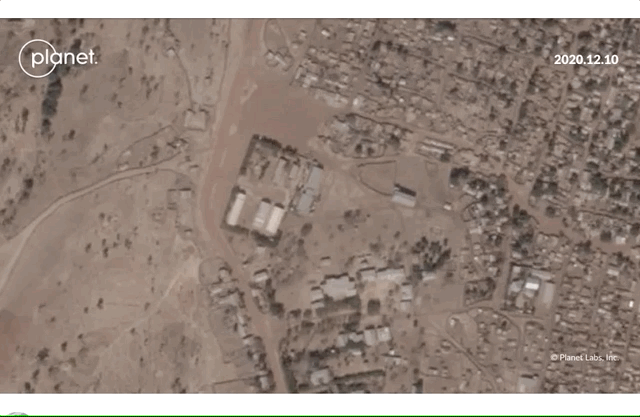

A time lapse shows the WFP building destroyed in the Shimelba camp.
Satellite images show the destruction The United Nations facilities, a health care unit, a high school and houses in two camps housing Eritrean refugees in Tigray, northern Ethiopia, the faithful government says the conflict in the dissident region has largely ended.
The eight The images of Planet Labs Inc are from Hitsats and Shimelba camps. The camps housed about 25,000 and 8,000 refugees, respectively, before a conflict erupted in the region two months ago, according to the United Nations High Commissioner for Refugees.

The smoke from the fires in the Hitsats camp.
“Recent satellite images indicate that the structures in both camps are intentionally targeted,” said Isaac Baker, an analyst at DX Open Network, a UK non-profit organization that conducts research and analysis on human security. “Systematic and widespread fires are in line with a campaign to deny the use of the camp.”
DX Open Network has been tracking the conflict and analyzing satellite imagery since Nov. 7, three days after Ethiopian Prime Minister Abiy Ahmed declared war on a dissident group in the Tigray region that dominated Ethiopian politics before Abiy came to power.

The Ethiopian government announced victory against dissidents on November 28 after federal forces conquered the regional capital Mekelle. Abiy spoke of the need to rebuild and restore Tigray’s normalcy at that time.
Calls and messages to Redwan Hussein, a spokesman for the government’s emergency working group on Tigray, and a spokesman for Prime Minister Abiy Ahmed, Billene Seyoum, went unanswered.
In Shimelba, the images show the scorched earth from the apparent attacks in January. A World Food Program storage facility and a high school run by the Development and Inter-Aid Church Commission were also burned, according to the DX Open Network analysis. In addition, between 5 January and 8 January, a health unit run by the Ethiopian Agency for Refugees and Returned Persons near the WFP complex was attacked.
In the Hitsats camp, about 30 kilometers away, there were at least 14 actively burning structures and another 55 were damaged or destroyed by January 5th. There were new fires until January 8, according to the DX Open Network analysis.

The UN refugee agency has not had access to the camps since the fighting began in early November, according to Chris Melzer, the agency’s communications officer. UNHCR has managed to reach its other two camps, Mai-Aini and Adi Harush, which are in the south, he said.
“We also do not have reliable, first-hand information on the situation in the camps or on the well-being of the refugees,” Melzer said, referring to Hitsats and Shimelba.
Eritrean troops have also been involved in the fighting and are accused of looting businesses and kidnapping refugees, according to humanitarian workers and diplomats briefed on the situation. The governments of Ethiopia and Eritrea have denied that Eritrean troops are involved in the conflict.
The UN says fighting is still ongoing in several Tigray areas and 2.2 million people have been displaced in the past two months. Access to the region for journalists and independent analysts remains restricted, making it difficult to verify events.
(Updates with the historian Tigray in the fourth paragraph)